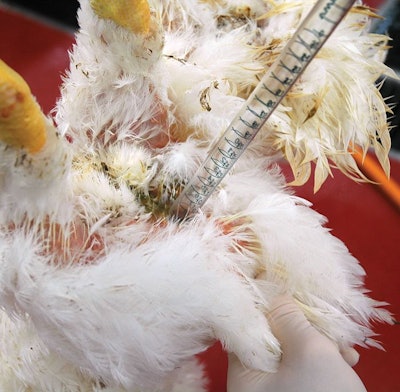
Applying an acidic solution to the cloaca of broiler carcasses before picking can significantly reduce Campylobacter contamination, according to a recent study by the U.S. Department of Agriculture Agricultural Research Service (USDA ARS).
Introduction
Campylobacter is associated with poultry and poultry products and is frequently isolated from fully processed broiler carcasses. Passage through a commercial feather-picking machine results in the large increase in the presence of Campylobacter on broiler carcasses. This is because the action of picker fingers forces small amounts of highly contaminated gut contents out of the cloaca and onto the carcass.
Controlling the escape of live Campylobacter from cloacae during feather removal could enable poultry processors to further reduce the presence of Campylobacter on fully processed products. Less Campylobacter bacteria on poultry meat would presumably reduce the risk of foodborne campylobacteriosis for consumers.
The experiment
We have studied several approaches to control Campylobacter contamination during feather removal including application of food-grade acids to kill Campylobacter in the cloaca before it can contaminate skin or meat.
We compared distilled white vinegar to one molar concentrations of: acetic acid at pH 2.3, lactic acid at pH 1.9, and proprionic acid at pH 2.4. Water treated, and untreated controls were included as reference points.
Broilers, 42 days old, were obtained from a commercial processing plant after 12 hours of feed withdrawal, caged in plastic coops and transported to the pilot processing facility at the U.S. National Poultry Research Center located in Athens, Georgia.
The birds were hung in commercial shackles, electrically stunned, killed and allowed to bleed-out. Next, each carcass was subjected to a manual squeeze to express contents from the cloaca.
Sampling method
Treatments were applied by pipetting up to 12 milliliters of acid into the cloaca of the test carcasses after bleed-out and before scalding. In this way, a dwell time of 2.5 minutes was assured as carcasses proceeded through three triple-pass scald tanks at 56 C (132.8 F).
After scalding, the shackle line was stopped so that each carcass could be examined by use of a sponge wipe method to sample breast skin. After sampling, all carcasses proceeded through a commercial-style feather picker. Following feather removal, all carcasses were sampled again using the same method.
Sample sponges were covered with phosphate buffered saline, mixed in a paddle blender and used to make serial dilutions, which were plated to enumerate Campylobacter by standard bacteriological methods. Sampling the same carcasses before and after feather picking allowed the use of a paired T-test for statistical analysis.

Passage through a picking machine results in the large increase in the presence of Campylobacter on carcasses. (Courtesy Mark Berrang)
Results
The number of Campylobacter on breast skin increased during feather picking as expected. However, carcasses that were untreated or treated with water experienced a much larger increase in Campylobacter numbers than did acid treated carcasses.
On average, we detected 15,848 cells on the breast skin of untreated carcasses and 10,000 on water treated carcasses. The number of Campylobacter bacteria detected on breast skin of acid treated carcasses were significantly less.
All acid treatments performed equally well. A range of 125 to 398 cells of Campylobacter were detected on post-pick breast skin of treated carcasses.

All acid treatments performed equally well in reducing the total number of Camplobacter bacteria detected post-pick. (Mark Berrang via U.S. Department of Agriculture Agricultural Research Service)
Practical applications
Practical use of this type of treatment in a commercial setting would require an engineering solution for rapid application of an antimicrobial liquid to the cloaca before scalding.
Cloacal treatment with food-grade acid would be expected to result in lower Campylobacter numbers on skin prior to the use of most major antimicrobial interventions currently applied in broiler processing. This would presumably allow commercial broiler companies to produce fully processed carcasses and parts with less Campylobacter contamination thereby helping to meet regulatory standards and lessen the risk of foodborne illness for consumers.

















